|
An
exceptional and rare outcrop of Proterozoic basement in the Tibesti (Chad)
Norbert Brügge, Germany
Dipl.Geol.
During the trekking tour
by FJExpeditions (Andras Zboray) in November/December 2022, a rare outcrop
of Proterozoic basement was found in a wadi at the eastern edge of the Tibesti
massif. Andras Zboray and Ursula Steiner provided the author
with photos for analysis.
Location
Description of the outcrop
The outcrop presents itself as a low rock wall on the western edge of a flat
wadi. Since in the affected area the Paleozoic sandstones have already eroded,
this suggests that this rock wall may be part of an exposed younger uplift.
After an initial visual geological analysis, it was immediately clear that
all of this are not Paleozoic sandstones. The appearance also rules out the
origin of the deposits from the Emi Koussi shield volcano.
The deposits are disturbed and partially brecciated internally. There is a
slip plane (fault) in the outcrop where an upper block has moved down. The
blocks differ from each other. A dark-red layer in the footwall of one block
is striking, followed by a bright layer without a chronological interruption.
The block that slid consists mainly of red deposits that contain bright spots
or bands.

1. Outcrop looking to southwest
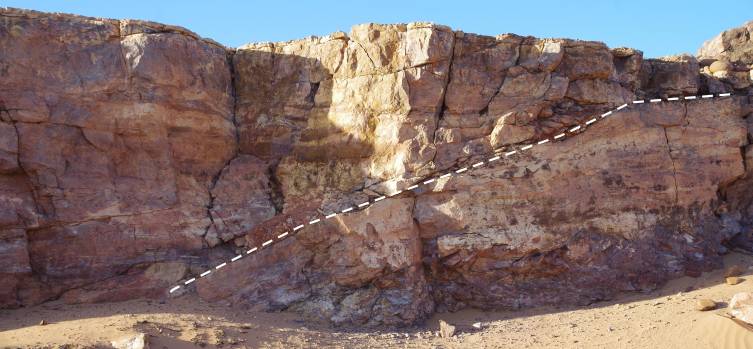
2. To south extended part of outcrop showing the slip
plane.
Outcrop block 1
The lower red, iron-rich layer is brecciated and appears to be iron-rich
compressed volcanic ash. Photos of a fragment could confirm it. A bright layer
follows without a time gap, but this is by no means sandstone. The texture
is not grainy and contains redish ferrous spots. Some easily recognizable
structureless parts give the impression that they are cherts. Cherts are components
of the Proterozoic "Banded Iron Formation" (BIF).
|
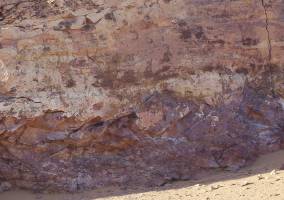
Representative sectiom of block 1 ---->
|
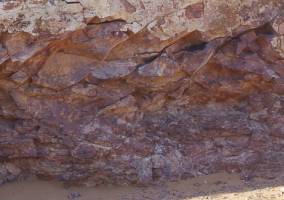
Transition from solidified and brecciated
ash (?) to chert
|
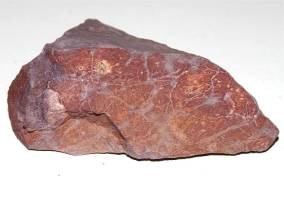
Solidified ash or other clasts with
cracks healed by quartz
|
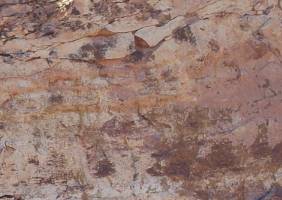
Nests of iron in chert
|
Outcrop block 2
This slipped part in the profile consists mostly of red ferruginous deposits
interspersed with bright colored chert bands. However, it cannot be verify
whether the red deposits are of ash or other small clasts. Such bands are
built up of accumulated clastics of psammitic or pelitic character. But they
are mostly fine-grained. The iron-rich bands alternating with silica-rich
bands consist of quartz (chert or jaspilite). There is no time gap (discordance)
within the block. The strata are a unit of red strata with bright cherts within.
This are no fluvial deposits, so no Paleozoic sandstones. It is definitive
Proterozoic BIF.
Conclusion
The outcrop with these Proterozoic BIF deposit is located within the underexplored
"East Sahara
Ghost Craton". They are deposits that have not been subjected by an orogeny
in "belts" and can therefore be considered intra-cratonal.
|